Flash Dance - a Carefully Planned Spontaneous Dance Event in Public Places
By Greg Rohde
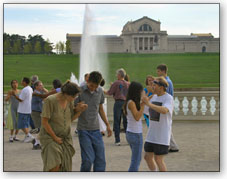 Imagine you’re strolling through a favorite park. You think you hear live music, but dismiss it as outlandish. The music persists, piques your curiosity, and captivates your interest. As you round a corner, you spy 20 couples waltzing as a pair of fiddlers play by a fountain. Sound like heaven? No, just St. Louis.
Imagine you’re strolling through a favorite park. You think you hear live music, but dismiss it as outlandish. The music persists, piques your curiosity, and captivates your interest. As you round a corner, you spy 20 couples waltzing as a pair of fiddlers play by a fountain. Sound like heaven? No, just St. Louis.
Ever hear of “flash mobs”? They’re seemingly spontaneous gatherings that briefly bring strangers together as they perform a common action. Well, since the summer of 2004, a few dancers in St. Louis instigated “flash dances” –seemingly spontaneous opportunities to waltz in public places. The series was a huge success and well worth the time required to plan it. Since dancers in other cities asked about the details behind the scenes, I’m compiling them here so you can host a “flash dance” in your own community.
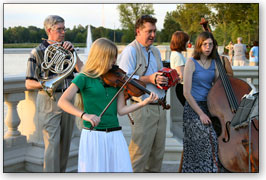 The Concept
The Concept
Mike Holdinghaus, a local musician, gets the credit for the original concept. He and his two fiddling daughters were looking for motivation to learn more waltzes. Mike imagined how wonderful it would be to play outdoors in public places so that a few waltzers could dance to their music, surprising and delighting any onlookers. “Waltz and Run” dancers would randomly appear here and there in flowing skirts with lovely music to twirl and glide and spin in front of amazed and appreciative civilians. We’d employ guerilla tactics to evoke joy and delight. News reports would lead with: “Another Drive-by-Waltzing…” I took his imagination and converted it to reality. The concept was simple: waltzing in public places. Putting it together meant finding a venue, providing music, and inviting dancers.
The Venues
The first step was to identify possible venues. Some came to mind quite easily. Others were unveiled as I cycled all over town scouting out sites. I searched for flat, open spaces that might have an aesthetic quality about them, either beauty or playfulness or uniqueness. Some were covered and others were totally exposed. Some surfaces were wood or concrete, while others were gravel or grass.
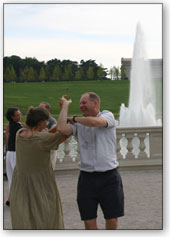 We generated a list of 30 possibilities and used 5 of them for our 7 dances in a 2 month period. Our first site was an 1872 wooden gazebo with an octagonal wooden dance floor.
We generated a list of 30 possibilities and used 5 of them for our 7 dances in a 2 month period. Our first site was an 1872 wooden gazebo with an octagonal wooden dance floor.
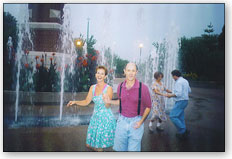 We danced through the fountains on a university campus mall, complete with a clocktower, waterfall, and 40 fountains to waltz through. Each fountain was a column of water shooting up 10 feet through a metal grate. The columns were four feet apart, allowing just enough room for a couple to choose between getting sprinkled or drenched if they dared to be grate waltzers.
We danced through the fountains on a university campus mall, complete with a clocktower, waterfall, and 40 fountains to waltz through. Each fountain was a column of water shooting up 10 feet through a metal grate. The columns were four feet apart, allowing just enough room for a couple to choose between getting sprinkled or drenched if they dared to be grate waltzers.
Another university campus offered gargoyles, beautiful architecture, graceful stone arches, wonderful details in the stonework, and an immense stone staircase with broad landings. (Waltzing up and down steps is a challenge.) On “National Night Out” we waltzed & contra danced at a block party so residents could literally “swing your neighbor.”
We twirled among giant water-lilies near faux ruins next to a large pond in a Tower Grove Park, and we danced at the Grand Basin at the foot of our art museum, in full view of scores of people renting boats or strolling along the water’s edge.
 Some venues were in the midst of a lot of pedestrian traffic. At these dances, we delighted the curious passersby. Some stopped to listen and watch while others accepted our invitation for a quick tutorial. When we danced under the gargoyles, one student made several cell phone calls to inform friends that “there’s live music in the quad.” Eventually we brought flyers for our local dances and had some passersby join us at our regular hall. Since this was a “spontaneous” gathering, we never asked for permission – we simply showed up. Campus Police and Park Rangers considered us a harmless oddity, allowing us to stay. If we were concerned that the authorities might not appreciate beautiful music on a warm summer night or if our venue was totally exposed and rain was forecasted, our publicity would include an alternative site and a cell phone number. I did get one call in advance from a concerned Park Administrator who had gotten wind of our scheme. I addressed his concerns and he eventually approved our planned spontaneity.
Some venues were in the midst of a lot of pedestrian traffic. At these dances, we delighted the curious passersby. Some stopped to listen and watch while others accepted our invitation for a quick tutorial. When we danced under the gargoyles, one student made several cell phone calls to inform friends that “there’s live music in the quad.” Eventually we brought flyers for our local dances and had some passersby join us at our regular hall. Since this was a “spontaneous” gathering, we never asked for permission – we simply showed up. Campus Police and Park Rangers considered us a harmless oddity, allowing us to stay. If we were concerned that the authorities might not appreciate beautiful music on a warm summer night or if our venue was totally exposed and rain was forecasted, our publicity would include an alternative site and a cell phone number. I did get one call in advance from a concerned Park Administrator who had gotten wind of our scheme. I addressed his concerns and he eventually approved our planned spontaneity.
Researching venues and composing dance announcements were the most time-consuming tasks. One helpful detail is providing clear directions, especially if the site is in a park or on a campus with unnamed roads or paths. I found it helpful to suggest a common parking spot and direct people from there. Web maps were very helpful for the email announcement. The email announcement usually included these details: date, time, Where to park, where to find us, maps, what makes this place unique, Dance surface, Alternate location, etc. If you want to do some extra planning, consider offering a meal option or suggesting a common color for people to wear.
As you brainstorm venues, think of beautiful parks, university campuses, riverfronts, lake fronts, pedestrian malls, playgrounds, public fountains, picnic areas, pedestrian walkways over highways, nature reserves, gazebos, highway rest stops, church grounds, subway stations, areas near museums, and areas near (but not on!) bike paths. Be creative! We chose to steer clear of airports, cemeteries, church interiors, federal monuments, train trestles, etc. Use your own discretion.
The Music
At our first event, our musicians knew only 3 tunes. We supplemented this with four customized CDs brimming with favorite waltzes. We affirmed that we didn’t care if the musicians repeated a piece later that night. As more musicians heard about the concept, they volunteered to play as well. One dance included 2 fiddlers, a mandolin, a concertina, a guitar, a stand-up base, and even a French horn. We always had CDs as a backup. One surreal night we had a Stringdancer CD playing while Martha Edwards, a Stringdancer fiddler, accompanied herself with live music.
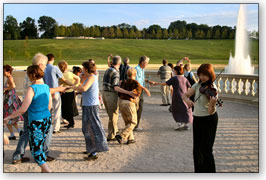 We threw in a few contras at half of the dances. Again, there was no set program, so we made it up as we went along. The capriciousness was part of the playfulness. Contras were an easy way to include spectators who were willing to give it a shot. Since we had no sound system, experienced dancers would prompt neighbors and partners if they couldn’t hear the caller. We found it easier to run two shorter lines so everyone could hear the calls. We also gained a great appreciation for “four potatoes”. It’s challenging for everyone to simultaneously jump out of your contra starting blocks for a first move when the CD dives right into a tune. “Ready, Set, Dance!”
We threw in a few contras at half of the dances. Again, there was no set program, so we made it up as we went along. The capriciousness was part of the playfulness. Contras were an easy way to include spectators who were willing to give it a shot. Since we had no sound system, experienced dancers would prompt neighbors and partners if they couldn’t hear the caller. We found it easier to run two shorter lines so everyone could hear the calls. We also gained a great appreciation for “four potatoes”. It’s challenging for everyone to simultaneously jump out of your contra starting blocks for a first move when the CD dives right into a tune. “Ready, Set, Dance!”
The Publicity and Turnout
The first dance was a delightful success. We were hoping for six to ten people. A dozen of our regular dancers gathered under a full moon in a beautiful Victorian gazebo. Two couples we didn’t know sought us out because someone forwarded them our email announcement. We danced for 45 minutes during a torrential downpour. The event was so appealing we offered it again. In keeping with the event’s “spontaneous” nature, we didn’t plan any farther out than “one more dance”. In setting a date, I’d offer a couple options to a few key dancers or musicians and then select one that most could attend. Publicity was simple: word-of mouth at our regular dances and an email announcement that dancers could forward to friends. Our largest crowd included several passersby and swelled to 80 people. The large crowd was a lot of fun, but expecting a crowd limits us from enjoying some quainter venues designed for no more than 10 couples.
Our dances ranged from 45 minutes to 2.5 hours, depending on how long people wanted to dance. We even had 30 hard core dancers show up on the hottest night of the summer – complete with water pistols, mist fans, and other ways to cool off. We scheduled our dances so they wouldn’t conflict with our established dances.
Onlookers joined us at every event. Tourists inevitably asked “How can I find this in my home town?”, so I directed them to www.tedcrane.com and encouraged them to find your dance hall. I promised them that you and your community would be hospitable. A few local onlookers loved it so much that they now attend our weekly dances and bring their friends, a benefit no one anticipated as we planned the first Flash Dance.
Another benefit no one envisioned was that our group’s waltzing skills improved. One woman missed our summer dances, and, when she re-joined us in the fall, commented on how some of the men’s leads improved over the summer. The flash dances turned out to be informal waltz workshops as our dancers taught each other new moves.
The Aftermath
Creativity, imagination, hospitality, playfulness, organization, and an eye for detail all combined for a delightful experience. Musicians played outdoors, dancers waltzed in beautiful venues, and passersby had great stories. All in all, quite heavenly.
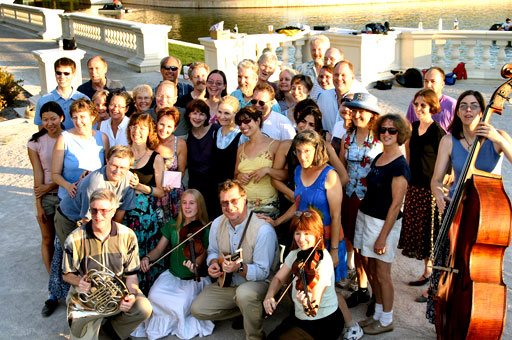
Click on picture for larger view of Flash Dancers at the Grand Basin on 8/8/04.
Sun 8/8/04. 6pm. Waltzing on the Water (WOW).
It was our 5th Flash Dance ever and the 2nd one at the Grand Basin.
We hosted 7 dances the first summer:
1) 7/2/04: Tower Grove Park Bandstand (full moon, 14 people, rain)
2) 7/13/04: Grand Basin (25 people, hottest night of the year)
3) 7/27/04: Wash U Brookings Hall (students join us)
4) 8/3/04: Gurney Ct Block Party
5) 8/8/04: Grand Basin #2 (Sun night. No waltz party. 80 people.)
6) 8/17/04: SLU’s Clocktower & Fountain
7) 8/29/04: Tower Grove Park #2 (near Lily Pads)
The 8/8/04 dance was our biggest Flash Dance that summer for 2 reasons: it was a Sun night when there was no Waltz Party and dancers were eager to dance somewhere; we were in a very public place and attracted a lot of passersby. Our "band" was 2 fiddles, a mandolin, a french horn, a stand up bass, and a boom box.
Flash Dance Trivia: Mike Holdinghaus presented the idea to Greg Rohde in a "Crazy Waltz Idea" email on 6/25/04. Mike and his daughters (Grace & Clare) wanted to play waltzes in Tower Grove Park, the MO Botanical Gardens, etc, and asked if we could fnd dancers to show up. We hosted the 1st Flash Dance 7 days later (it didn't take much arm twisting) and then scoured the city for more "Cool Places to Waltz" offering 7 Flash Dances that first summer, and we've been doing them from time to time ever since.
Happy Dancing!

